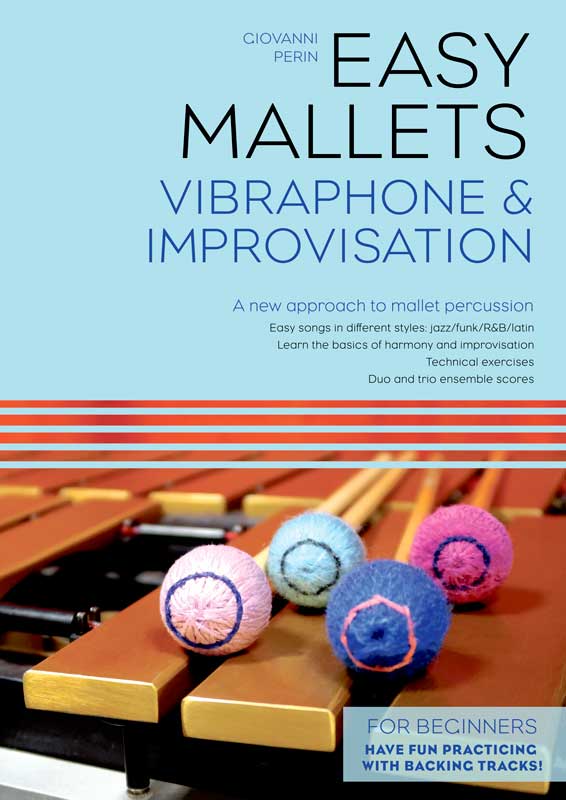Easy Mallets
When I began my career as a percussion teacher, I found there was a lack of easy material that was both fun to play and preparatory for beginners.
That’s why I decided to write etudes in different styles (classical, blues, jazz, Latin, R&B), that were both enjoyable to play and easy enough for understanding the basic principles of movement involved on mallet instruments. The two Easy Mallets books (Marimba & Xylophone; Vibraphone & Improvisation) that comprise these etudes were written to be used simultaneously as they complement each other.

EASY MALLETS – VIBRAPHONE & IMPROVISATION
I teach my students (even the classical one) to learn how to improvise right from the beginning of their studies, in order to remove the fear of playing without reading music.
In the book dedicated to the Vibraphone & Improvisation the students will learn how to improvise using basic harmonic structures in different styles (swing, latin, blues, shuffle, R&B, boogaloo…).
Improvisation is not only a great way to develop creativity, sense of rhythm, musicality and ears, but it is also an amazing practice routine that will unconsciously make the students understand the mechanics of their hands while getting familiar with the instrument.
When we learn to improvise, we learn instrument fluency; we learn the natural connection between a musical idea, its manifestation in sounds we can control, and we learn to link sound devices to our own musical voice.
I will explain some of the basic concepts of improvisation, dispelling many myths behind this musical art and giving creative advice that will encourage the students to let go of the need to be perfect and let themselves be playful.
They will become aware of the fundamental harmonic and melodic concepts at the base of music (an area where percussionists often find themselves unprepared).

EASY MALLETS – MARIMBA & XYLOPHONE
In this volume you will find classical etudes written in a more traditional style, but always with an eye on students who want to learn while having fun, without getting bored!
In fact, the book was born with the idea of learning the basic movements of the two-mallet technique, bypassing the old and boring keyboard methods. Each etude presents a simple technical exercise at the top of the page which will then be developed into a fun and captivating piece of music. There is also a section dedicated to scales and arpeggios in all major and minor keys.

EASY MALLETS – FAMOUS SONGS
This new collection of the Easy Mallets series called Famous Songs was created to please the kids who often ask me to play known melodies. I also prepared the backing tracks for each song to make the lesson even more fun.
In addition, each tune is provided with a very easy written accompaniment part for piano or marimbas that can be played with friends. The main melody can be performed with any mallet instrument.
How to Use Backing Tracks
EASY MALLETS: VIBRAPHONE & IMPROVISATION
EASY MALLETS: MARIMBA & XYLOPHONE
After I tried the songs with my students, I realized that they need backing tracks to help them keep time and keep going without getting stuck over and over again in the same bar. For this reason, I recorded the play-alongs, so that they could have fun while practicing at home.
The backing tracks can be found here and on my YouTube page channel under the playlist called Easy Mallets.
For the books called Marimba & Xylophone and Famous Songs you will find three versions of the play along. The first version has the melody recorded on top of it. The second one has a slower recording of it, so that the student can gradually develop speed and control on the instrument. The third one has just the backing track with the original tempo.
I suggest first to listen to it. Get through the material slowly with the metronome and only when everything is clear, start to work with the slower version of the backing track. It’s really important that students record themselves while practicing, both with and without the play-along, in order to keep track of their progress.
The tracks of the book called Easy Mallets, Vibraphone & Improvisation that involve improvised parts are recorded twice (6 tracks in total): one version contains the solo section, the other one is without it. There are also two extra tracks (one has the original tempo and one is slower) for practicing only the solo section following the suggestions I give about improvisation techniques and how to practice them. You can choose whether or not to play the solo, but I encourage you to give it a try, I’m sure you’ll have fun!
- Brecker’s Tune // #pera - Giovanni Perin
- Lost In A Violet Sky // #pera - Giovanni Perin
- Conversation With Dave // #pera - Giovanni Perin
- Rebuilt // #pera - Giovanni Perin
- Star Eyes // #pera - Giovanni Perin
- Darn That Dream // #pera - Giovanni Perin
- A Sunny Day In Berlin Town // #pera - Giovanni Perin

